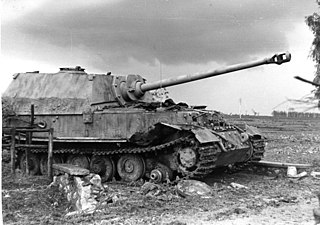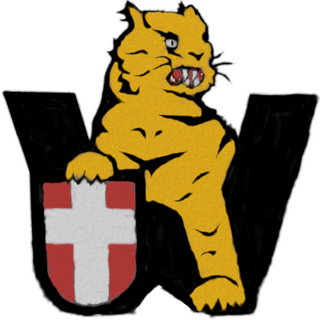
The 1st Panzer-Division was an armoured division in the German Army during World War II.
101st Heavy SS Panzer Battalion was a German heavy tank battalion in the Waffen-SS during World War II. With the introduction of new Tiger II tanks in late 1944, the unit was renumbered as the 501st Heavy SS Panzer Battalion.

The 13th Panzer Division was a unit of the German Army during World War II, established in 1940.

The Panzer-Lehr-Division was an elite German armoured division during World War II. It was formed in 1943 onwards from training and demonstration troops stationed in Germany, to provide additional armored strength for the anticipated Allied invasion of western Europe. On 4 April 1944, the division was officially designated as the 130th Panzer Division; however, it is usually referred to as the Lehr Division. It was the only Wehrmacht Panzer division to be fully equipped with tanks and with halftracks to transport its mechanized infantry. On several occasions it fought almost to destruction, in particular during Operation Cobra, and by the end of the war in Europe bore little resemblance to the unit that had originally been activated.

The 60th Infantry Division was formed in late 1939, from Gruppe Eberhardt, a collection of SA units that had been engaged in the capture of Danzig during the Invasion of Poland. This division was unusual in that its manpower was largely drawn from the SA and the police.

III Army Corps was a corps level formation of the German Army during World War II.
The Panzerkorps Feldherrnhalle was a German army corps that fought on the Eastern Front during the Second World War. It was formed of Sturmabteilung (SA) members. Unlike the Waffen-SS, Feldherrenhalle operated under the Wehrmacht Heer.
The 509th Heavy Panzer Battalion was a German heavy Panzer Abteilung, equipped with heavy tanks, during the Second World War.
The 7th Panzer Division was an armored formation of the German Army in World War II. It participated in the Battle of France, the invasion of the Soviet Union, the occupation of Vichy France, and on the Eastern Front until the end of the war. The 7th Panzer Division is also known by its nickname, Ghost Division.

A German heavy tank battalion was a battalion-sized World War II tank unit of the German Army (1935–1945), equipped with Tiger I, and later Tiger II, heavy tanks. Originally intended to fight on the offensive during breakthrough operations, the German late-war realities required it to be used in a defensive posture by providing heavy fire support and counter-attacking enemy armored breakthroughs, often organised into ad hoc Kampfgruppen.

The Infantry Regiment Großdeutschland was an élite German Army ceremonial and combat unit which saw action during World War II. Originally formed in 1921 it was known as the Wachregiment Berlin. Renamed Infanterie-Regiment Großdeutschland in 1939, the regiment served in the campaigns in France and the Low Countries. It then served exclusively on the Eastern Front until the end of the war. It was destroyed near Pillau in May 1945.

The 502nd Heavy Panzer Battalion was a German heavy tank battalion during World War II. The battalion was the first unit to receive and field the Tiger I. It fought on the Eastern front. It was one of the most successful German heavy tank battalions, claiming the destruction of 1,400 tanks and 2,000 guns. Otto Carius, one of the best German tank aces, was a member.
The 501st Heavy Panzer Battalion was a German heavy Panzer Abteilung equipped with heavy tanks. The battalion was the second unit to receive and use the Tiger I heavy tank, changing to Tiger IIs in mid-1944.
The 508th Heavy Panzer Battalion was a German heavy Panzer Abteilung, during World War II, equipped with heavy tanks. It fought at Anzio and later defended German-held Northern Italy opposing the Allies during the Italian Campaign. It fought in Italy until it surrendered at the end of the war in May 1945.
The 102nd Heavy SS Panzer Battalion was a German heavy tank battalion of the Waffen-SS during World War II. It fought as part of the II SS Panzer Corps during the Battle of Normandy and was nearly destroyed. Renumbered as 502nd Heavy SS Panzer Battalion in late 1944, the unit was destroyed in the Halbe Pocket in Spring 1945.
103rd Heavy SS Panzer Battalion was a German heavy tank battalion of the Waffen-SS during World War II.
The 510th Heavy Panzer Battalion was a German heavy Panzer Abteilung, equipped with heavy tanks. The 510th saw action on the Eastern Front during the Second World War.

The 653rd Heavy Panzerjäger Battalion was a tank destroyer unit of the German Wehrmacht active during World War II. It was equipped with Ferdinand and later Jagdtiger tank destroyers. Elements of the battalion served on the Eastern, Western, and Italian fronts between 1943 and 1945.

Operation Southwind was a German offensive operation on the Eastern Front in Hungary, from 17–24 February 1945. The Germans succeeded in eliminating the Soviet bridgehead on the west bank of the river Hron in preparation for Operation Spring Awakening. This was one of the last successful German offensives in the Second World War.

The 506th Heavy Panzer Battalion was a german heavy Panzer Abteilung equipped with Tiger I tanks until 28 July 1944. During the period from 20 August to 12 September 1944, it was re-equipped with a full complement of 45 Tiger Ausf. B tanks. Some of the first Tiger IIs delivered to the 506th were examples fitted with the early production turret. The battalion saw action on the Eastern and Western Fronts during World War II. As with other German heavy tank battalions, it was attached as needed to larger formations. The 506th was unique in being the only Tiger battalion to include a fourth company. German: schwere Panzerkompanie Hummel, equipped with Tiger I tanks, was consolidated with the 506th in 1944. It was also unique in that it regularly received new vehicles and replacements from other units to maintain a full complement. The unit served until the collapse of the Ruhr Pocket in April 1945, being officially disbanded by the battalion commander on 14 April. The unit performed well despite often poor conditions of deployment, officially credited with over 400 tank kills during its service with fewer than 75 combat losses.













